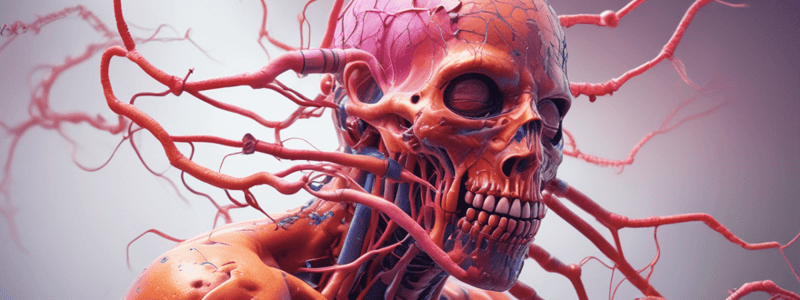Podcast
Questions and Answers
Which factor contributes to the risk of infection in hospitalized patients?
Which factor contributes to the risk of infection in hospitalized patients?
- Impaired immunity (correct)
- Consumption of vitamins
- Exposure to sunlight
- Regular exercise routine
What is an example of a potential entry point for infection in hospital patients?
What is an example of a potential entry point for infection in hospital patients?
- Regular handwashing
- Initial insertion of a medical device (correct)
- Consuming a healthy diet
- Exposure to fresh air
What is cited as an additional risk factor for infection in hospital patients?
What is cited as an additional risk factor for infection in hospital patients?
- Trauma including surgery (correct)
- Adequate sleep patterns
- Regular physical therapy sessions
- Sufficient hydration levels
Which type of infection is associated with MRSA auto-infection?
Which type of infection is associated with MRSA auto-infection?
What is a common source of cross-infection in hospitals?
What is a common source of cross-infection in hospitals?
What is the main method of transmission for pathogens like MRSA and foodborne infections?
What is the main method of transmission for pathogens like MRSA and foodborne infections?
Which type of pathogens can remain suspended in the air for long periods and access the lower respiratory tract?
Which type of pathogens can remain suspended in the air for long periods and access the lower respiratory tract?
What is a characteristic of pathogens like M.tuberculosis and measles regarding their transmission?
What is a characteristic of pathogens like M.tuberculosis and measles regarding their transmission?
Which statement best describes the traditional medical distinction that is now being replaced by a more scientific classification?
Which statement best describes the traditional medical distinction that is now being replaced by a more scientific classification?
What is a characteristic feature of droplet transmission from an infected person?
What is a characteristic feature of droplet transmission from an infected person?
Where are pathogens like S.aureus primarily sourced from when leading to wound infections?
Where are pathogens like S.aureus primarily sourced from when leading to wound infections?
What is one of the impacts of Healthcare Associated Infections (HAI) mentioned in the text?
What is one of the impacts of Healthcare Associated Infections (HAI) mentioned in the text?
Why are point prevalence surveys done every few years?
Why are point prevalence surveys done every few years?
Which bacteria are specifically mentioned in the text as 'alert organisms' likely acquired in the hospital?
Which bacteria are specifically mentioned in the text as 'alert organisms' likely acquired in the hospital?
Why is surveillance of Healthcare infection important in hospitals?
Why is surveillance of Healthcare infection important in hospitals?
What is one role of the Infection Control Service mentioned in the text?
What is one role of the Infection Control Service mentioned in the text?
Why do some bacteria infect patients in hospitals who would not normally be infected by them?
Why do some bacteria infect patients in hospitals who would not normally be infected by them?
Which of the following is NOT a characteristic of Enterobacterales/Enterobacteriaceae?
Which of the following is NOT a characteristic of Enterobacterales/Enterobacteriaceae?
According to the 2017 Europe-wide prevalence survey in Ireland, what was the overall rate of healthcare-associated infections (HCAI)?
According to the 2017 Europe-wide prevalence survey in Ireland, what was the overall rate of healthcare-associated infections (HCAI)?
Which of the following was NOT one of the leading healthcare-associated infections (HCAI) identified in the 2017 survey?
Which of the following was NOT one of the leading healthcare-associated infections (HCAI) identified in the 2017 survey?
According to the 2017 survey, what percentage of patients with healthcare-associated infections had an infection caused by Clostridium difficile?
According to the 2017 survey, what percentage of patients with healthcare-associated infections had an infection caused by Clostridium difficile?
Which of the following organisms was the most common cause of healthcare-associated infections, according to the 2017 survey?
Which of the following organisms was the most common cause of healthcare-associated infections, according to the 2017 survey?
What is the primary cause of diarrhea following antibiotic therapy, according to the text?
What is the primary cause of diarrhea following antibiotic therapy, according to the text?
According to the passage, which type of transmission is associated with large particles that settle on the ground within 1 meter and less than 5 minutes?
According to the passage, which type of transmission is associated with large particles that settle on the ground within 1 meter and less than 5 minutes?
What is the key difference between droplet and aerosol/airborne transmission according to the passage?
What is the key difference between droplet and aerosol/airborne transmission according to the passage?
According to the passage, what is the recommended distance to maintain to prevent droplet transmission?
According to the passage, what is the recommended distance to maintain to prevent droplet transmission?
Which of the following is NOT mentioned in the passage as a countermeasure for droplet transmission?
Which of the following is NOT mentioned in the passage as a countermeasure for droplet transmission?
Based on the passage, which of the following statements about respiratory particles is true?
Based on the passage, which of the following statements about respiratory particles is true?
What is the significance of the statement in the passage about 1000 frames per second images of a sneeze?
What is the significance of the statement in the passage about 1000 frames per second images of a sneeze?




